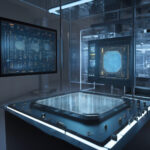Student-built world’s first portable nuclear detector to redefine radiation monitoring
In a bid to revolutionize fields such as clean energy research, environmental monitoring, and medicine, a group of innovative students has developed the world’s first portable nuclear detector. This groundbreaking device is set to redefine radiation monitoring as we know it and pave the way for more efficient and accessible detection methods.
The portable nuclear detector, created by a team of engineering students from a renowned university, is compact in size yet powerful in functionality. Utilizing advanced technology and innovative design, this device is capable of detecting various types of radiation with high precision and accuracy. What sets this detector apart from traditional monitoring devices is its portability, allowing for on-the-go measurements and real-time data analysis.
One of the key advantages of this student-built nuclear detector is its versatility. From monitoring radiation levels in nuclear power plants to detecting radioactive contamination in the environment, this device can be used in a wide range of applications. In the field of medicine, the portable detector shows promise for enhancing cancer treatment procedures by enabling more precise radiation therapy delivery.
Moreover, the affordability of this student-built detector makes it accessible to a wider audience, including researchers, healthcare professionals, and environmental agencies. By democratizing access to advanced radiation monitoring technology, the team behind this innovation aims to empower individuals and organizations to make informed decisions regarding radiation safety and exposure.
The development of the world’s first portable nuclear detector underscores the potential of student-led initiatives in driving technological innovation. By harnessing their creativity, technical skills, and passion for positive change, these students have demonstrated the impact that young minds can have on the scientific community.
As we look towards the future, the implications of this portable detector are vast. It has the potential to enhance nuclear safety protocols, improve environmental monitoring practices, and advance medical treatments involving radiation. By redefining radiation monitoring through innovation and ingenuity, the student-built nuclear detector is poised to shape the way we approach and understand radiation detection.
In conclusion, the world’s first portable nuclear detector developed by a team of students represents a significant milestone in the field of radiation monitoring. With its compact design, advanced capabilities, and affordability, this device has the potential to revolutionize how we detect and measure radiation in various settings. As we witness the impact of this innovative technology unfold, it becomes evident that the future of radiation monitoring is indeed in the hands of the next generation of inventors and visionaries.
radiation monitoring, nuclear detector, student innovation, technological advancement, scientific breakthrough











